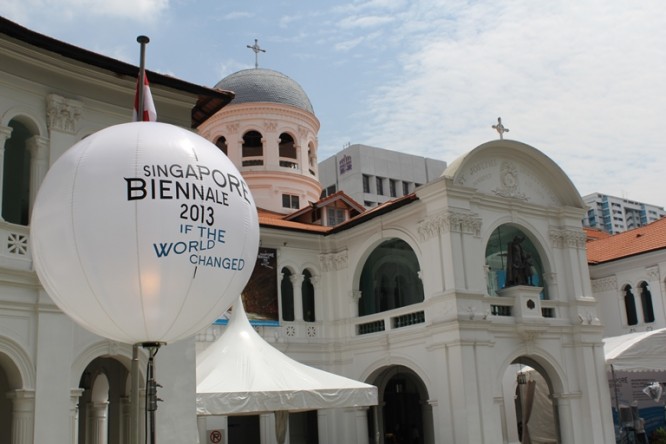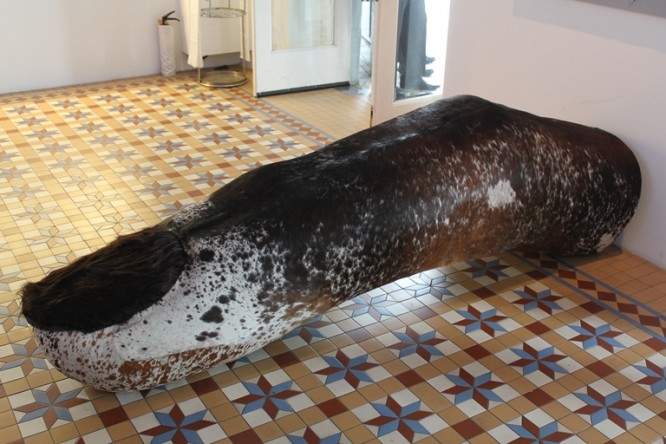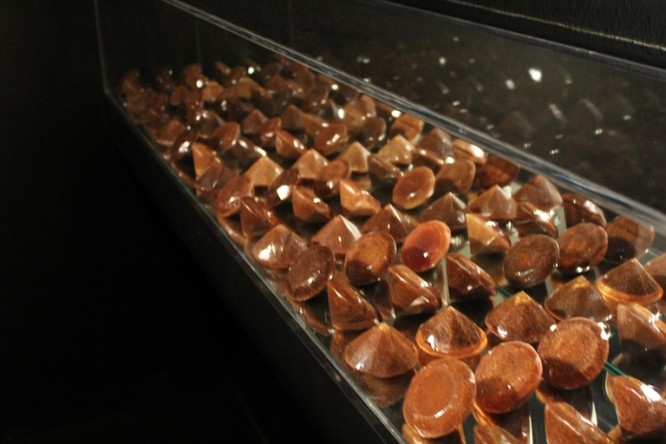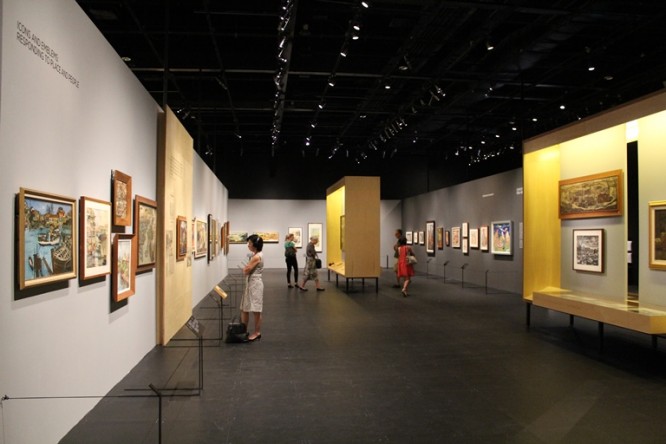“If the World Changed”: 4th Singapore Biennale
Various locations, Singapore. Oct 26, 2013–Feb 16, 2014
Yavuz Can, the founder of Yavuz Fine Art, is impatient with the question of whether the Singapore Biennale—any Biennale—is “good” or “bad”. A biennale should equally be about what a single person can gather from it as showing the artistic spirit and forms of a place or region—on both sides, aspects which can’t necessarily be judged positive or negative, “yes” or “no”, and not least because a biennale contains so many exhibitions and art works. This is something worth remembering every time: what are the expectations of such an event? So personal a thing is it for an art work to really speak to you that to take even one such experience from a biennale containing myriad works—as is true for the broader flow of exhibitions—makes the whole exercise worthwhile.
This year’s Singapore Biennale officially contains 82 works—over half of them commissioned for the occasion—spread across ten venues in the center of the city. Singapore Art Museum (SAM) is the focal point, with the National Museum of Singapore, The Peranakan Museum, the National Library and Singapore Management University included in the list. An ecstatic opening ceremony drew crowds of people and fanfare from the announcer plus a hired drumming performance with flaming torches on the lawn. No one could accuse the organizers of lacking energy.

The 2013 Singapore Biennale (now into its 4th edition) drops the standard format of a single Artistic Director guiding decisions about the theme and selection of works. Instead, a “curatorium” of no less than 27 curators with localized expertise across South East Asia were put behind the still distinctly Biennale-ish title “If the World Changed”. At the press conference, an assembled number of them told us “There are many Asias in Asia,” that this is about melting down the conventional national pavilion idea (as seen in Venice), showing different South East Asian elements simultaneously and saying “This is us” with less geographical labelling. The decision to have 27 curators started with “What SAM staff don’t know” about the art in different places in the region, and also avoided the trend for international curators who tour the globe and reappear at every major event. The latter was envisaged for the art works, too (though there was one which some will recall seeing at dOCUMENTA—the mesmeric post-apocalyptic video work “El Fin del Mundo” (2012) by Moon Kyungwon and Jeon Joonho).
So, though Singapore was asserted as an international site, the focus was not on “international” figures and works in the sense of the global art-world circuit. Rather, the aim was expressed fervently in terms of focusing on the region, and “intensity”—SAM putting its arms, as it were, around it all, and away from the usual suspects. The title logo, with words pointing at different angles from the center like a signpost, seems apt. Apparently, the curators were barely given guidelines for their choices, and in any case (according to the former SAM Director Tan Boon Hui), the aim is not always for a finished product; not having one, he asserted, reveals “creativeness”, with unresolved conflict and a degree of assemblage helping to “break the cycle”. Clearly, disputes had arisen and some ends gone untied, though overall one sensed the earnestness of the sentiment.


But if there had been some scuffles behind the scenes, one wouldn’t have known it from the show. Everything was ready and prepared; the works were well and sometimes thoughtfully presented. The sculptures of index fingers by the Vietnamese artist Tran Tuan, for example (“Forefinger”, 2013), are carefully arranged on the floor in the atrium and initial anteroom of the museum, one pointing accusingly at the reception booth, others curling darkly next to the passageway. In general, one could observe that the art works tended towards narrative and socio-political bases. Among the works at SAM, for example, the “Forefinger” pieces just mentioned reference a practice in Vietnam by victims of war and its traumas of cutting off their trigger fingers to avoid being conscripted for future conflicts. Upstairs, Nikki Luna’s work “Tiempos Muertos (Dead Season)” (2013) is close to 1,000 diamond shapes arranged in grid formation in glass cases around three walls. Each is a resin case filled with sugar, marking the human cost—and financial gain by plantation owners—of the industry in the Philippines. The boat on the ground floor by Ahmad Abu Bakar (“Telok Blangah”, 2013) is piled with bottles, their labels handwritten notes by prison inmates in Singapore which express their consciences about their situations, hopes and feelings. Across the road, at the SAM annex building, 8Q, one could find a large painting done with soil on canvas by the Talaangig Artists collective. Using colors made from the different clay soils in their ancestral lands, they express their traditions, history, place and spirit—determining themselves against such forces as agricultural corporations in the modern world.
As always, one noticed a consensus about certain works. Khvay Samnang’s 5-channel untitled video piece (2011-13) in 8Q shows the artist neck deep in water in different public lakes in Phnom Penh, pouring a bucket of sand over his head—an act symbolizing their being filled in by the government for private sale as land. Outside 8Q is a wooden stall—literally a shack hung with different items—glass jars, a rubber ring, woven mats, a bird cage, pots, masks, a sailor suit, stickers and jelly moulds. This is “Toko Keperlaun” (2010, 2013) by Anggun Priambodo. All are items the artist finds useless, but that others might find useful. Hence, they are for sale (your correspondent was grateful for a new percolator) at the artist’s invitation—simultaneously a symbol of the vanishing old provisions shops found in Singapore and Priambodo’s native Indonesia, and a comment on consumerism enacted though knick-knacks.


At SAM, visitors strained to perceive the minute wooden figures carved by Toni Kanwa for his “Cosmology of Life” (2013) installation; not far away, the 4,000 kg of red seeds piled in a red room by Kumari Nahappan—“Anahata” (2013)—and conceived to symbolize possibility, drew attention with its simple yet plural form. Also upstairs at SAM, the impressive arched structure erected by Nguyen Oanh Phi Phi and lined with Vietnamese lacquer was likened to a Byzantine chapel and Vietnamese village gates by different sets of visitors standing inside.
But it was the Japanese outfit teamLab which finally stole the show. The interactive digital installation “Peace Can Be Realized Even Without Order” (2012) wowed with its movement-sensitive light and sound performance.
Elsewhere, notable exhibitions running parallel to the Biennale are an informative historical show at the National Museum: “A Changed World: Singapore Art 1950s-1970s” and “Lost to the Future: Contemporary Art from Central Asia”. Curated by former Lasalle College of the Arts’ curatorial director Charles Merewether, the latter is a fantastic show of work; its tone, somewhat deliberately, is at odds with the worthy zeal of the Biennale. At the Singapore ARTrium, too, the “Spot Art” festival is worth the trip; “Sculpture Square”, down the road from SAM, is rather less so. In what is still a nascent art scene in Singapore, the biennale perhaps has yet to really support the galleries—works were commissioned directly from the artists, and one couldn’t be sure whether the crowds at the opening would translate into footfall for the commercial exhibitions at gallery enclave, the Gillman Barracks, for example, which is also government-sponsored.
In all, the 4th Biennale in Singapore shows no sign that momentum there is slowing—quite the opposite. In the words of a seasoned observer, this is “The start of something big.” Even if one didn’t meet art that seared itself into the memory this time, curiosity and confidence are in place for the next.


